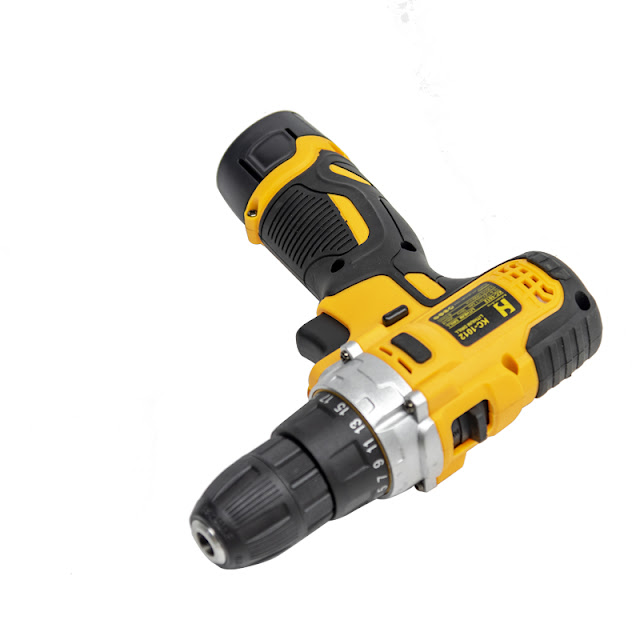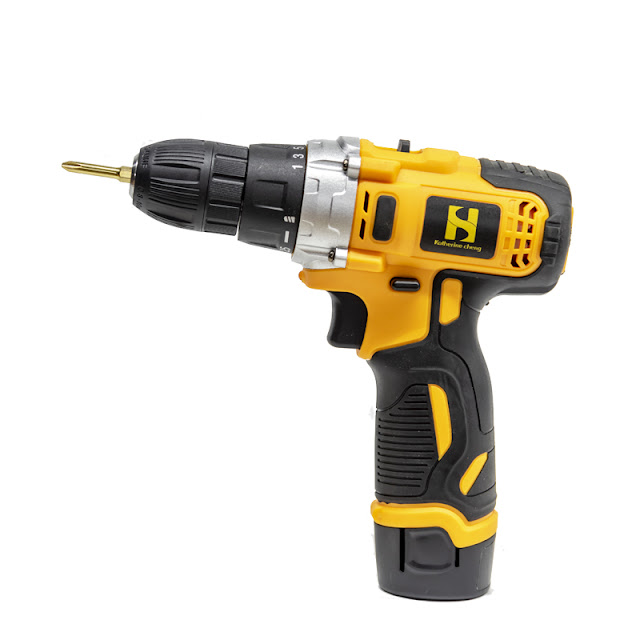Hansheng Tools Overview
It is a conventional product in power tools, and it is also the most demanded power tool product. Annual production and sales account for 35% of China’s power tools. The main specifications of electric drills are 4, 6, 8, 10, 13, 16, 19, 23, 32, 38, 49mm, etc. The numbers refer to the maximum diameter of the drill bit drilled on steel with a tensile strength of 390N / mm2. For non-ferrous metals, plastics and other materials, the maximum diameter can be 30 to 50% larger than the original specification.
working principle
The working principle of the electric drill is that the motor rotor of the electromagnetic rotary or electromagnetic superimposed small-capacity motor performs magnetic field cutting and power operation. The operating mechanism is driven by the transmission mechanism, which drives the gear to increase the power of the drill, thereby making the drill scrape the surface of the object and better hole penetration object.
application
Electric drills are widely used for the strengthening, decoration, decoration, wall installation, brackets, railings, billboards, air conditioners, guide rails, satellite receiver elevators, steel structure workshops, etc. of building beams, boards, columns, and walls.
classification
Electric drills can be divided into three categories: hand drills, impact drills, and hammer drills.
1. Hand drill: The power is the smallest, and the scope of use is limited to drilling wood and an electric screwdriver. Some hand drills can be changed to special tools according to the purpose. There are many uses and models.
| Hansheng tools |
2. Impact drills: There are two types of impact mechanisms for impact drills: dog teeth and ball type. The ball-type impact drill is composed of a moving disk, a fixed disk and a steel ball. The moving disk is connected to the main shaft through threads and has 12 steel balls. The fixed disk is fixed on the casing by pins and has 4 steel balls. Under the action of thrust, 12 steel balls roll along 4 steel balls. The cemented carbide drill produces rotary impact motion and can drill holes in brittle materials such as bricks, blocks, and concrete. Remove the overhead nails to make the fixed plate rotate with the moving plate without impact, which can be used for ordinary electric drills.
3. Hammer drill (electric hammer): can drill holes in a variety of hard materials, the most widely used.
Selection Guide
The selection of electric drills needs to be combined with their respective scope and requirements. Difference between hand drill, impact drill, hammer drill and electric pick:
The hand electric drill simply relies on the motor to drive the transmission gear to increase the strength of the drill to make the drill penetrate through the scraping form on the metal, wood and other materials.
There are two adjusting knobs at the drill chuck, adjustable drill and impact drill. However, the impact drill uses the gears on the inner shaft to beat each other to achieve the impact effect, and the impact force is far less than that of the electric hammer. It can also drill reinforced concrete, but the effect is not good.
| Hansheng tools |
The hammer drill (electric hammer) is different. It uses the bottom motor to drive two sets of gear structures, one to drill it, and the other to drive the piston, just like the hydraulic stroke of the engine, which generates a strong impact force. effect. Strength can split the stone into gold.
The electric pick is a bouncing operation made by the electric motor to shake, so that the pick has the effect of chiseling the ground. The hydraulic pump picker uses the gas pressure transmitted by the air compressor to drive the pump hammer in the electric picket to bounce back and forth, so as to produce the effect of the picket hitting the ground.
maintenance
Because electric drills need to be ventilated and dissipated, there is a lot of internal dust in the long-term use. The dust will cause the lubricant on the gears and bearings (sliding sleeves) to be mixed and deteriorated, which will increase the wear and tear, especially for alternative uses. In order to ensure the rotation accuracy of the electric drill and reduce the excessive gap caused by the wear of the bearing (slip sleeve), it is extremely necessary to keep it clean and greased.
method:
Loosen a few self-tapping screws or screws outside the electric drill; lay flat and lift half of the shell; generally the structure of the new hand drill is semi-embedded, that is, all mechanical and electrical components are installed in the other half of the shell
Carefully remove the carbon brush first, then remove the end of the drill chuck, and then gently lift the motor to take out the rotor (do not damage the enameled wire), and wipe the commutator on the rotor (the one that is in contact with the carbon brush is), if it is too dirty Or if it is very worn, you can sand it with abrasive cloth first and then use water sandpaper or metallographic sandpaper to shine.
If the front and rear bearings of the rotor are sealed, the outside can be wiped clean. If the seal is broken, it should be replaced in time. Wipe the helical gear shaft in front of the rotor
Clean off the oil inside the case. Clean the helical gear and the bearings (or bushings) on both ends of the drill chuck.
Replace the removed parts, first install the rotor; then install the chuck rod helical gear; install carbon brushes, if the carbon brushes are shorter than 7-8 mm, replace them with new ones in time. The carbon brush must be installed and flattened. Finally, find a bit of “Mobil” or “Shell” grease and add all the parts between the gear pair and the bearing (or shaft sleeve). Tighten the screws and turn by hand to feel that there is no stagnation.
Precautions
Pay attention to the following points when using electric drills:
1. Personal protection when using electric drill
(1) Wear a protective mask when working with your face up. Wear protective glasses to drill holes in pig iron castings to protect the eyes.
(1) The drill holder should be properly installed.
(3) The drill is in a hot state during operation, and care should be taken to burn the skin.
(4) A side-handed pistol drill should be used when drilling a handheld electric drill with a diameter of Φ12mm or more.
(5) When standing on a ladder or working at a high place, take measures to fall from a high place. The ladder should be supported by ground personnel.
2. Matters needing attention before operation
(1) Confirm that the power source connected to the site matches the nameplate of the drill. Whether a leakage protector is connected.
(2) The drill and holder should be fitted and properly installed.
| Hansheng tools |
(3) Confirm that the switch on the electric drill is in the locked state; otherwise, the electric drill will rotate unintentionally when the plug is plugged into the power outlet, which may cause personal injury.
(4) If the work place is far from the power source, when the extension cable is needed, use a sufficient capacity and install a qualified extension cable. Extension cables should be elevated or walked through the sidewalk to prevent the cables from being crushed and damaged.
Troubleshooting
A hand drill’s failure often manifests itself as: after the power is turned on, the motor does not respond, causing the drill to fail to work properly; or the motor turns more slowly, resulting in a reduction in the impact force of the hand drill; in addition, the failure of the electric drill is also manifested in the noise of the motor during operation Too big, the electric drill won’t tremble. These will cause the hand drill to malfunction and affect its normal work.
1.The motor cannot work normally
Disassemble the electric drill body and check whether the fuse is blown or the power cord is blown. If there is such a problem, the fuse or power cord should be replaced immediately; it may also be due to damage to the armature winding or stator winding, which must be replaced or Repair windings; it may also be due to bearing rust. Lubricate or derust the bearing. There is also that the brush does not contact the surface of the commutator, and the position of the brush needs to be checked to make it in contact with the commutator.
2.The motor speed slows down
This is due to severe wear of the brushes and should be replaced immediately. However, the carbon brush of any electric drill should be replaced once every 200 jobs. If the electric drill is not powered during work or the machine suddenly stops rotating during normal work, the first thing to think of is that the carbon brush has run out.
3.Excessive motor noise
(1) Caused by wear of brushes or bearings, which requires replacement of brushes and bearings;
(2) If the axial thrust exceeds the Ambassador electric drill’s overload, the thrust should be reduced;
(3) If the bearing is too tight or the gear is broken, replace the gear immediately after stopping the work;
(4) The mechanical transmission part is stuck.
4.The motor rotates but the shaft does not rotate
(1) The key on the drill shaft is broken; (2) The main gear is broken; (3) The gear part of the armature shaft is broken.
| Hansheng tools |



















Replies
Violation, please contact me to delete
Spammy spamm spammer
The explanation is very detailed.
Wow I like this drill,where to buy?
Please send me your shop link~
Spammy spam spam spammer
This forum post is now archived. Commenting has been disabled